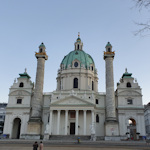
As you might imagine, Vienna has accumulated a fair few churches, whether Gothic giants or Baroque jewels. Here’s an overview of some of the more historical and notable locations and buildings.
- Book a classical concert* in a church or palais
- See also:
Churches and cathedrals
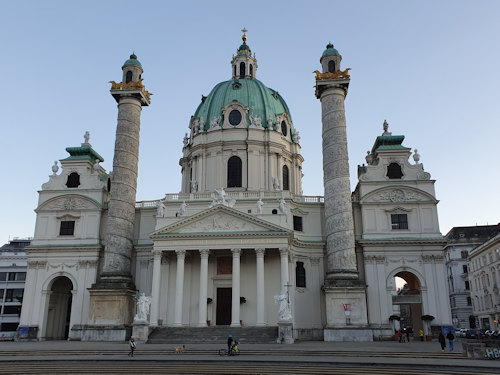
(The Karlskirche)
First off, a quick linguistic tip. The local word for church is Kirche and the one for cathedral is Dom. Once you know that, the names of churches become far clearer to the English-speaking mind.
So Michaelerkirche, for example, is the church of St. Michael, and Stephansdom is St Stephen’s cathedral.
Dozens of churches add their architectural flair to the Viennese landscape. Some date back to before the founding of the Duchy of Austria in the 13th century. Others have particular connections to Vienna’s long list of composers, such as Haydn, Bruckner, Schubert, Beethoven and Mozart.
Indeed, the central churches in particular often provide a home for orchestras performing the works of the great Viennese composers in public concerts.
Below you’ll find links to articles about all the churches I cover here at Visiting Vienna, with more to come as I get to them.
Location map
Stephansdom
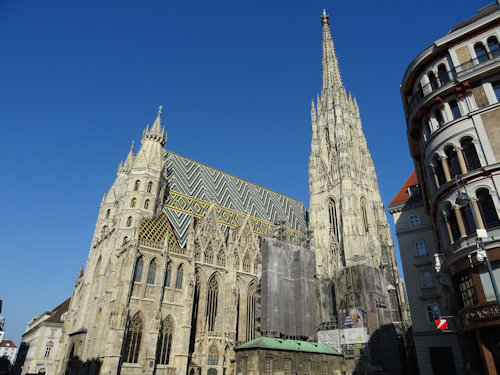
(The famous mosaic roof replaced the one damaged in a 1940s fire)
Let us begin with the undoubted leader of the ecclesiastical gang. Stephansdom cathedral dominates the heart of the city in both a physical and spiritual sense.
Notable features of this gothic giant are the multicoloured tiled roof, the huge sarcophagus of Emperor Frederick III (1415 – 1493), and the mighty pummerin bell that rings in the New Year for all of Austria.
Climbing the south tower gives you wonderful views across the city centre, and the catacombs tour delivers the kind of dank, bone-filled chambers you might expect.
The cathedral also hosts performances of classical music. I enjoyed the regular giant organ concert, for example.
Peterskirche
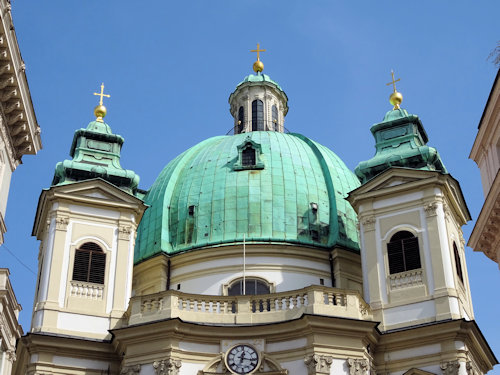
(The dome mirrors its namesake – St. Peter’s Basilica – in Rome)
If you find the gothic Stephansdom too plain for your liking, then pop along the Graben pedestrianised street to the Baroque Peterskirche.
The insides of this early 18th-century church feel like an explosion of decorative magnificence. Also notable as a concert venue: here’s my review of the recurrent performances by the Classical Ensemble Vienna.
Karlskirche
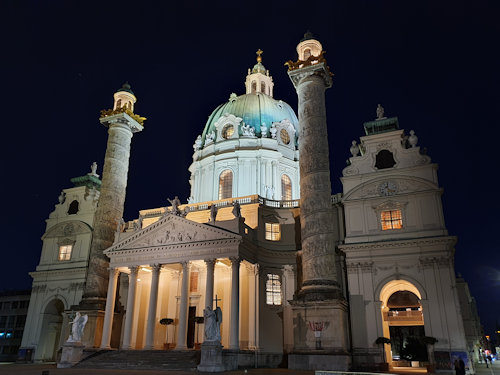
(One of Vienna’s most notable buildings)
Another monumental building that dominates the park before it. Emperor Charles VI built the gorgeous Karlskirche church as thanks for the passing of the plague. An early 18th-century construction with suitable Baroque décor.
Be sure to take the stairs up to the organ, small treasury, and outdoor terrace with views across the square to such iconic buildings as the Musikverein.
The church hosts performances of Vivaldi’s The Four Seasons, which I review here; the composer is buried under the neighbouring university.
Votivkirche
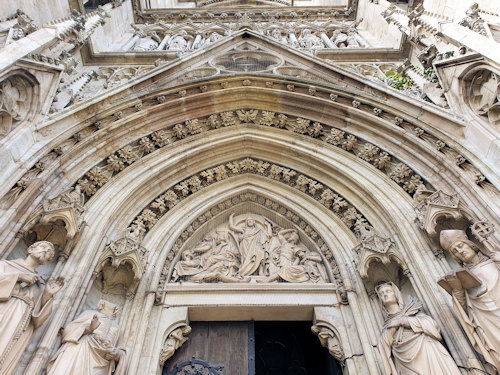
(An entrance to the Votivkirche)
This neogothic cathedral-like church looks like something you might find in medieval England or France. Surprisingly, the Votivkirche still awaits its 150th birthday.
The church owes its existence to a failed assassination attempt on Emperor Franz Joseph in 1853. His brother raised funds to build this monumental expression of thanks for the monarch’s survival.
Kirche am Steinhof
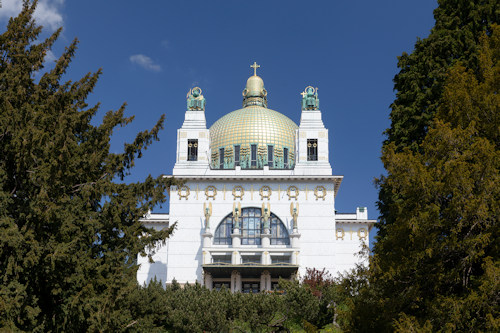
(The church sits on top of a hill that houses medical facilities; press photo by Lisa Rastl © Wien Museum)
The Kirche am Steinhof went up in 1907 as the church serving what was then a new psychiatric hospital.
This white and gold building forms a true jewel in the landscape and may well be the pinnacle of Jugendstil architecture in Vienna. The interior is spacious, airy and stunning, with the white and gold theme continuing everywhere (but especially in the decorative altar and pulpit).
Annakirche
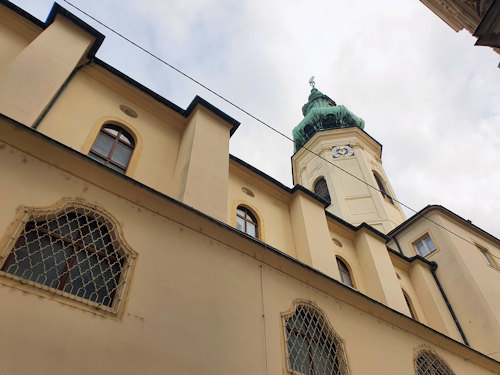
(Wait until you see inside)
This little gem sits unobtrusively down a pedestrianised old town side street, where its shy exterior suggests a workmanlike church entirely lacking in ostentation.
Then you go inside.
The interior of the Annakirche is a Baroque masterpiece that quite takes your breath away. Another top venue for classical music.
Michaelerkirche
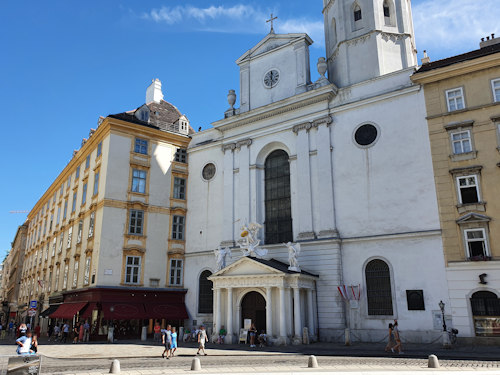
(The church looks out onto the central and historical Michaelerplatz square)
Visiting the Michaelerkirche feels like its own tour through history; parts date back to the 13th century. The colours had dried on one wall painting about 100 years before the end of the Byzantine Empire.
Incidentally, Mozart’s incomplete Requiem in D Minor premiered here in 1791 at the requiem service for the great composer.
Kapuzinerkirche

(The frescoes are actually a 20th-century addition)
The Capuchin monastery in Vienna has a church that faces out onto Neuer Markt square right in the centre. This Kapuzinerkirche dates back to the 1600s, also hosts concerts, and makes for a nice refuge from old town bustle.
Perhaps most importantly from the visitor’s perspective, the church’s crypts count as one of the more historically important such locations in Austria and wider Europe. Inside you find the final resting places of dozens of Habsburg emperors, empresses and other family members.
Augustinerkirche
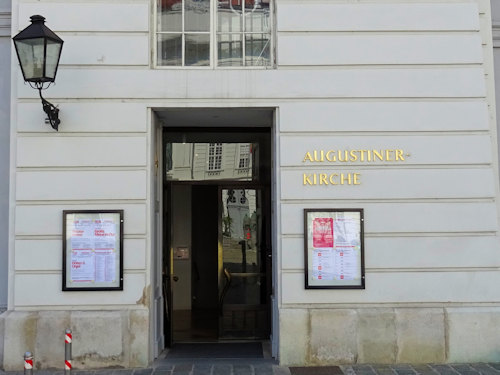
(The unobtrusive entrance)
Like the Annakirche, another church with an innocent looking exterior. The 14th-century Augustinerkirche adjoins the winter palace complex of the Habsburgs at Josefsplatz.
Once the official court church, the marriage records of this institution contain a fair few famous names. Marie Antoinette, for example: the then Archduchess Maria Antonia married the future Louis XVI of France in the absence of the bridegroom.
Hofburgkapelle
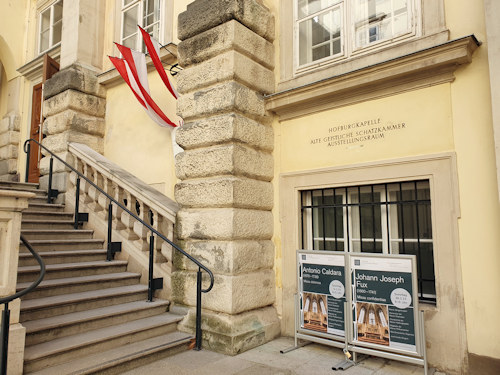
(And another unobtrusive entrance)
Embedded within the Hofburg palace complex you’ll find the Hofburgkapelle or Imperial Court Chapel, which served the local residents from a time when Austria was just a small duchy.
The location also acts as the home of the Wiener Hofmusikkapelle: a state ensemble consisting of singers and musicians drawn from Vienna’s most prestigious musical institutions. The ensemble performs during Holy Mass services.
Alserkirche
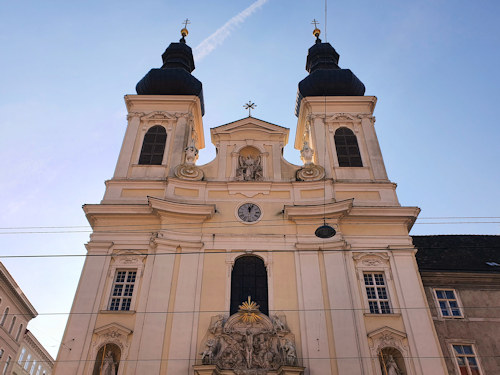
(A church with a close musical connection)
Completed in 1704, the Alserkirche enjoys a particular musical connection. It was here in 1827 that Beethoven’s coffin was blessed before heading to the cemetery for burial.
Schubert also wrote music for the church, whose visitors included a detachment of Napoleonic troops in 1812. The soldiers set up camp in the crypt (!).
Schubertkirche
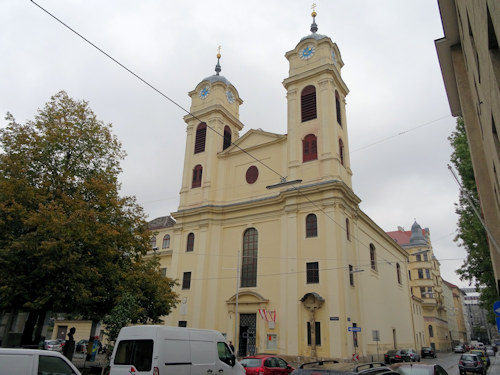
(The name offers a clue to the composer connection)
Everyone knows the Lichtentaler parish church as the Schubertkirche, which offers a rather big hint as to the name closely associated with this early 18th-century building.
Franz Schubert sang in the choir, played the organ, wrote music for the church, and was even christened here.
Piaristenkirche
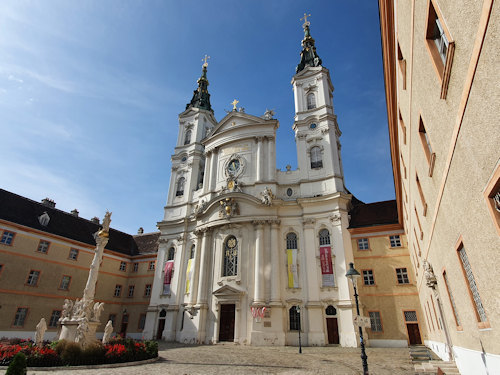
(Also known as the Maria Treu parish church)
Baroque delights exist outside the very centre, too. Take the Piaristenkirche, for example. This built-in-one church offers a little more subtlety than some of its genre colleagues and a few surprises, like a deceptive façade.
Bruckner took his music composition exam on the organ here. The church also hosted premieres of works by Joseph Haydn.
Minoritenkirche
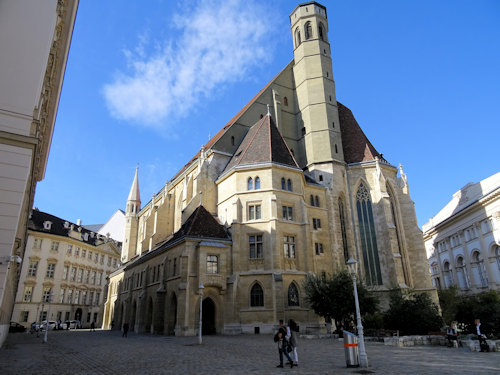
(The tower served as a lookout point during sieges)
Although right in the centre of Vienna, the large 14th-century Minoritenkirche still manages to occupy a somewhat secluded spot just behind Palais Niederösterreich.
Home to the Italian congregation, the church also enjoys a top reputation as a venue for classic concerts, gospel choirs and other musical delights.
Waisenhauskirche
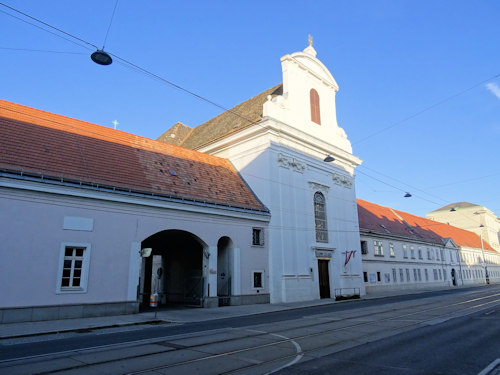
(Mozart performed here as a child)
In Vienna, even small churches in nondescript parts of the city enjoy their musical claim to fame.
Mozart wrote and conducted the music for the consecration of the Waisenhauskirche, for example, in 1768. He was just twelve at the time.
Ruprechtskriche
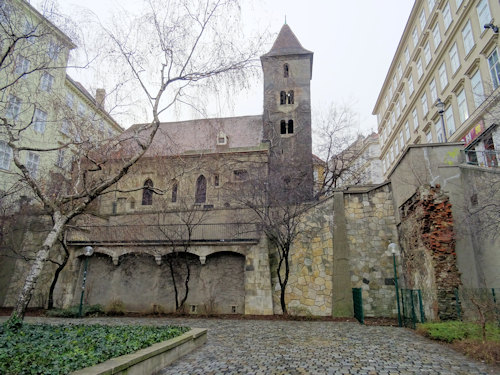
(Also an outdoor location for the classic movie, The Third Man)
All the above are mere babies compared to the Ruprechtskirche, likely built around 800 (that’s not a typo). Unimaginably old when you consider all that’s happened over the past 1200+ years.
This working Romanesque church has experienced a few rebuilding projects in the meantime but still sits proudly above the old city walls. It looks down onto an arm of the Danube at the edge of the old town.
Maria am Gestade
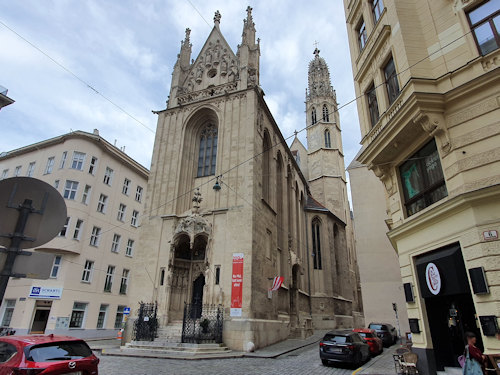
(Like the Ruprechtskirche, Maria am Gestade also features in The Third Man. As does the Minoritenkirche!)
The Ruprechtskirche gets a little historical competition from Maria am Gestade, an unusual Gothic church with origins in the dark ages before Austria became a duchy.
The church’s name and location have to do with a riverbank that no longer exists, thanks to the capricious nature of the Danube in past times.
The narrow design and a subtle kink in the layout reflect the original shoreline location, which meant adjusting the floorplan to the limited space available.
Schottenkirche
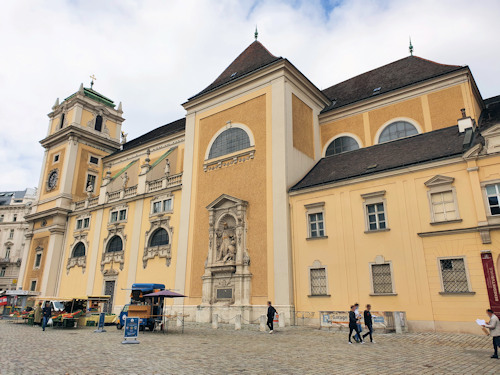
(The Freyung square in front hosts lovely Easter and Christmas markets)
Another church that has seen a fair few Viennese winters: the Schottenkirche serves the surrounding Schottenstift abbey in the city centre, a venerable institution that dates back to the 12th century.
Most of the church is resplendently Baroque in nature now, but part of the original Romanesque building remains.
The crypt houses one of Vienna’s most famous sons. Actually, Heinrich II. Jasomirgott might be better considered a famous father, since he was the first Duke of Austria and moved his court here around the middle of the 1100s.
Kirche am Hof
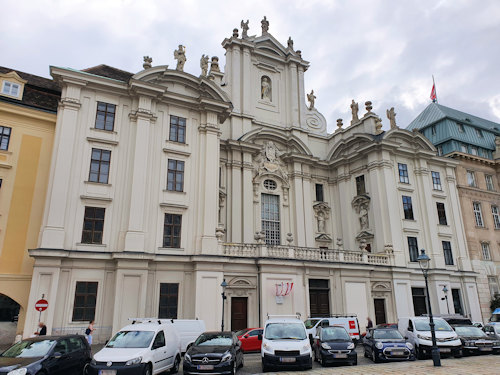
(Popes Pius VI, John Paul II, and Benedict XVI all appeared on the balcony)
The Kirche am Hof towers over the large Am Hof square in central Vienna. The Baroque façade hides the fact that the building actually dates back to the late Middle Ages.
The balcony you can see in the photo has its own particular claim to fame, having supported the feet of no less than three popes.
Wotrubakirche
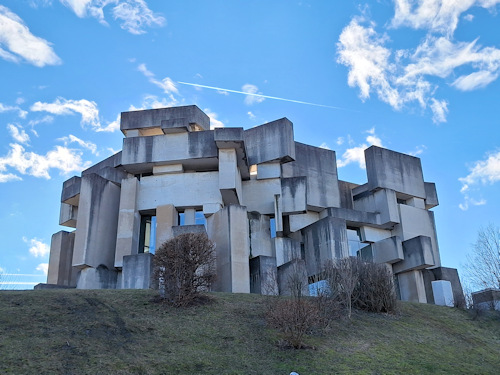
(Considered a gem of brutalist architecture)
And now for something completely different. Forget your Baroque beauties and Gothic grandeur. Instead, enjoy the brutalist-style Church of the Holy Trinity, better known as the Wotrubakirche.
Completed in 1976, the church takes its name from the sculptor Fritz Wotruba, who designed the building in collaboration with the architect Fritz Mayr.
Bonus abbeys
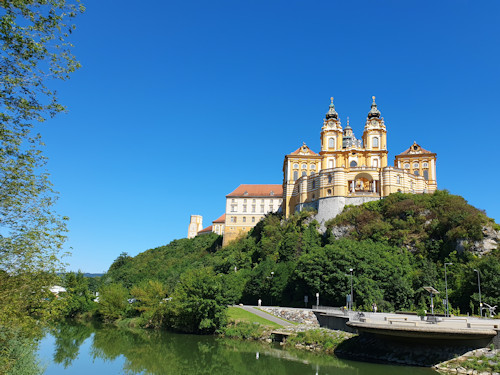
(The Benedictine Melk abbey)
Not in Vienna as such, but two nearby abbey complexes make an easy trip out of the city:
- Klosterneuburg: on the very edge of Vienna with a Baroque imperial wing and some rather wonderful items in the treasury and elsewhere, including the famous Verdun altar
- Melk: famously perched above the town on an outcropping. A seamless Baroque façade with its own historical treasures and a library that leaves you gasping